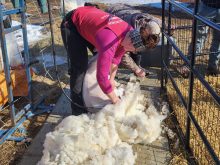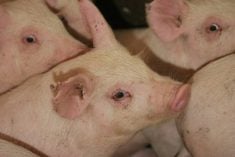LETHBRIDGE – After 20 years, timothy production remains a success for Alberta hay growers.
But Canadian livestock does not get a nibble of this specialty forage exported almost exclusively to Japan and South Korea.
About 300,000 tonnes of timothy hay leave 10 Alberta processing plants each year for Asia, where it is fed as a high quality, highly digestible fibre to dairy cattle and racehorses.
Timothy is a tall, leafy grass with narrow green heads that resemble cattails.
Japanese buyers are willing to pay an average $330 per tonne, so growers and processors are willing to do extra to give them what they want. About two percent is rejected compared to about five percent in the early days of the industry in the mid-1980s.
Read Also

Charges laid after cattle theft
Saskatchewan RCMP lay two charges against a man after six cattle went missing.
“The rejections are not quality related, they are protocol related,” said Green Prairie International special projects manager Brand Beekman. About one third of Alberta’s timothy exports are handled at Green Prairie east of Lethbridge.
Random inspections of containers full of tightly packed hay occur at the port of entry, and if anything wrong is found, the order is rejected.
“A lot of times we don’t even get visual proof of what they found,” Beekman said.
Rejections may be quality based on the level of greenness of the product, or due to mouldy bales that were exposed to condensation during transport in the shipping container.
The hay must also be free of visible pests like mice or moths, seeds, weeds, dirt, rocks or foreign objects like pieces of metal that may have been picked up in the field during cutting and baling.
Of particular concern is finding Hessian flies in a container.
This fly attacks grain crops and the Japanese do not want it or any of the host plants migrating to their country where they could attack rice fields. Hosts include straw, wheat, barley, foxtail barley and quackgrass. The presence of any of these could cause Japanese authorities to reject a load at the port.
Green Prairie is researching methods to destroy the Hessian fly without chemicals. Its research shows compressing the bales with high pressure kills any flies or larvae present.
“We have to ensure there are no contaminants so we are working on X-ray scanning of the product,” Beekman said.
Mistakes can be costly. If an order is rejected for any reason there is no way to recover the hay or shipping costs. Insurance is usually purchased to cover losses.
Traceback information is attached to every order starting in the farmer’s field to the final destination in Asia.
“Lot traceability and quality issues really come to roost. The Japanese pay more than anybody else in the world for hay, so they feel entitled to a high quality product,” said Beekman.
Green Prairie keeps up to 12,000 tonnes on site for processing, with the large square bales stored in a covered shed. The company also owns a plant at Crossfield north of Calgary where small bales are accepted.
The Lethbridge plant is a fully automated system, running round the clock six days a week. Fifteen containers holding 25.5 tonnes of hay are shipped from this site each day. They are trucked to Calgary and sent by rail to Vancouver.
Machines do all the heavy lifting, slicing, measuring and baling. The only handwork is pulling off the plastic twine before the bales go through the first cutting machine.
The bales are compressed using more than 1,600 pounds per sq. inch of pressure. The result is a tightly packed cube measuring half a metre across and weighing about 27 kilograms.
Before shipment, the bales are moisture tested with the optimum being less than 12 percent moisture to prevent condensation in the container, said Lloyd Van Eeden Petersman of Green Prairie.
While the company used to deal mostly with hay brokers, the business is shifting toward working with individuals, where the hay goes straight to the Asian farmer.
“It is easier to deal with the end user than the wholesaler who views it as a commodity,” said Van Eeden Petersman.
When Canada got involved in this industry it was not so sophisticated, said Joe Lim. He has been a marketer of timothy hay since the business began. At that time about 60,000 tonnes a year were produced.
Lim started dealing with it in 1980 in California where it was fed to racehorses. It was also being exported in small amounts to Japan for racehorses but eventually some farmers started feeding it to their young dairy cattle. Lower quality hay is fed to beef cattle.
South Korea opened in the early 1990s. There is a minimum access quota that is dependent on domestic forage production. The Koreans are more price conscious than the Japanese so export levels vary.
About 60 percent of the perennial crops come off irrigated land, where the first cut starts at the end of June.
A second cut of lesser quality comes later in the season. Dryland harvest starts in the second week of July. Alberta grows about 95 percent of the timothy on 80,000 acres.
“The climate here is conducive to this crop,” said Lim.
Smaller amounts are grown in Saskatchewan and Manitoba.

















